Effects of Selenium Nanoparticle Application on Flavor Volatiles of Aromatic Rice
Abstract
1. Introduction
2. Materials and Methods
2.1. Plant Materials and Field Conditions
2.2. Experimental Design
2.3. Plant Sampling and Determination of Flavor Volatiles
2.4. Statistical Analysis
3. Results and Discussion
3.1. The Number and Type of Flavor Volatiles After SeNP Application
3.2. Relation Between Flavor Volatiles and Flavors
3.3. PCA of Flavor Volatiles
3.4. Effects of Nano-Se on Contents of Different Flavor Volatiles
4. Conclusions
Author Contributions
Funding
Data Availability Statement
Conflicts of Interest
References
- Hinge, V.R.; Patil, H.B.; Nadaf, A.B. Aroma volatile analyses and 2ap characterization at various developmental stages in basmati and non-basmati scented rice (oryza sativa l.) Cultivars. Rice 2016, 9, 38. [Google Scholar] [CrossRef]
- Ruan, S.; Luo, H.; Wu, F.; He, L.; Lai, R.; Tang, X. Organic cultivation induced regulation in yield formation, grain quality attributes, and volatile organic compounds of fragrant rice. Food Chem. 2023, 405, 134845. [Google Scholar] [CrossRef]
- Li, S.; Li, H.; Lu, L.; Shao, G.; Guo, Z.; He, Y.; Wang, Y.; Yang, X.; Chen, M.; Hu, X. Analysis of rice characteristic volatiles and their influence on rice aroma. Curr. Res. Food Sci. 2024, 9, 100794. [Google Scholar] [CrossRef]
- Li, M.; Li, R.; Liu, S.; Zhang, J.; Luo, H.; Qiu, S. Rice-duck co-culture benefits grain 2-acetyl-1-pyrroline accumulation and quality and yield enhancement of fragrant rice. Crop. J. 2019, 7, 419–430. [Google Scholar] [CrossRef]
- Cheng, S.; Liu, H.; Li, H.; Li, K.; Zheng, L.; Su, M.; Lin, X.; Huang, G.; Ren, Y. Riboflavin improves grain yield, 2-acetyl-1-pyrroline accumulation, and antioxidative properties of fragrant rice. J. Sci. Food Agri. 2024, 104, 1178–1189. [Google Scholar] [CrossRef]
- Chen, Y.; Hua, X.; Li, S.; Zhao, J.; Yu, H.; Wang, D.; Yang, J.; Liu, L. Aromatic compound 2-acetyl-1-pyrroline coordinates nitrogen assimilation and methane mitigation in fragrant rice. Curr. Bio. 2024, 34, 3429–3438. [Google Scholar] [CrossRef]
- Chen, P.; Shaghaleh, H.; Hamoud, Y.A.; Wang, J.; Pei, W.; Yuan, X.; Liu, J.; Qiao, C.; Xia, W.; Wang, J. Selenium-Containing organic fertilizer application affects yield, quality, and distribution of selenium in wheat. Life 2023, 13, 1849. [Google Scholar] [CrossRef]
- Yan, G.; Wu, L.; Hou, M.; Jia, S.; Jiang, L.; Zhang, D. Effects of selenium application on wheat yield and grain selenium content: A global meta-analysis. Field Crop. Res. 2024, 307, 109266. [Google Scholar] [CrossRef]
- Li, S.; Chen, H.; Jiang, S.; Hu, F.; Xing, D.; Du, B. Selenium and nitrogen fertilizer management improves potato root function, photosynthesis, yield and selenium enrichment. Sustainability 2023, 15, 6060. [Google Scholar] [CrossRef]
- Hussain, S.; Ahmed, S.; Akram, W.; Sardar, R.; Abbas, M.; Yasin, N.A. Selenium-Priming mediated growth and yield improvement of turnip under saline conditions. Int. J. Phytoremediat. 2024, 26, 710–726. [Google Scholar] [CrossRef]
- Zhang, H.; Du, B.; Jiang, S.; Zhu, J.; Wu, Q. Potential assessment of selenium for improving nitrogen metabolism, yield and nitrogen use efficiency in wheat. Agronomy 2023, 13, 110. [Google Scholar] [CrossRef]
- Shi, M.; Zhang, T.; Fang, Y.; Pan, C.; Fu, H.; Gao, S.; Wang, J. Nano-selenium enhances sugarcane resistance to xanthomonas albilineans infection and improvement of juice quality. Ecotox. Environ. Safe. 2023, 254, 114759. [Google Scholar] [CrossRef]
- Hussain, B.; Lin, Q.; Hamid, Y.; Sanaullah, M.; Di, L.; Hashmi, M.L.U.R.; Khan, M.B.; He, Z.; Yang, X. Foliage application of selenium and silicon nanoparticles alleviates cd and pb toxicity in rice (oryza sativa l.). Sci. Total Environ. 2020, 712, 136497. [Google Scholar] [CrossRef]
- Huang, S.; Qin, H.; Jiang, D.; Lu, J.; Zhu, Z.; Huang, X. Bio-nano selenium fertilizer improves the yield, quality, and organic selenium content in rice. J. Food Compos. Anal. 2024, 132, 106348. [Google Scholar] [CrossRef]
- Huang, S.; Yu, K.; Xiao, Q.; Song, B.; Yuan, W.; Long, X.; Cai, D.; Xiong, X.; Zheng, W. Effect of bio-nano-selenium on yield, nutritional quality and selenium content of radish. J. Food Compos. Anal. 2023, 115, 104927. [Google Scholar] [CrossRef]
- Goel, M.; Grover, N.; Batra, D.; Garg, N.; Tuwani, R.; Sethupathy, A.; Bagler, G. Flavordb2: An updated database of flavor molecules. J. Food Sci. 2024, 89, 7076–7082. [Google Scholar] [CrossRef]
- Gu, Q.; Luo, H.; Lin, L.; Zhang, Q.; Yi, W.; Liu, Z.; Yu, X.; Zuo, C.; Qi, J.; Tang, X. Effects of biological nano-selenium on yield, grain quality, aroma, and selenium content of aromatic rice. Agronomy 2024, 14, 1778. [Google Scholar] [CrossRef]
- Okpala, N.E.; Potcho, M.P.; An, T.; Ahator, S.D.; Duan, L.; Tang, X. Low temperature increased the biosynthesis of 2-AP, cooked rice elongation percentage and amylose content percentage in rice. J. Cereal Sci. 2020, 93, 102980. [Google Scholar] [CrossRef]
- Luo, H.; Imran, M.; Yao, X.; Zhang, S.; Yi, W.; Xing, P.; Tang, X. Foliar application of glutamate and phenylalanine induced regulation in yield, protein components, aroma, and metabolites in fragrant rice. Eur. J. Agron. 2023, 149, 126899. [Google Scholar] [CrossRef]
- Anandakumar, P.; Kamaraj, S.; Vanitha, M.K. D-limonene: A multifunctional compound with potent therapeutic effects. J. Food Biochem. 2021, 45, e13566. [Google Scholar] [CrossRef]
- Gokila, G.; Premalatha, K.; Shanmugam, P.S.; Suganya Kanna, S.; Pradeep, S. Herbivore-induced plant volatiles in rice: A natural defense mechanism shaping arthropod community. Appl. Ecol. Environ. Res. 2024, 22, 3047–3058. [Google Scholar] [CrossRef]
- Sun, Z.; Lyu, Q.; Chen, L.; Zhuang, K.; Wang, G.; Ding, W.; Wang, Y.; Chen, X. An hs-gc-ims analysis of volatile flavor compounds in brown rice flour and brown rice noodles produced using different methods. LWT 2022, 161, 113358. [Google Scholar] [CrossRef]
- Chen, T.; Li, H.; Chen, X.; Wang, Y.; Cheng, Q.; Qi, X. Construction and application of exclusive flavour fingerprints from fragrant rice based on gas chromatography—Ion mobility spectrometry (gc-ims). Flavour Frag. J. 2022, 37, 345–353. [Google Scholar] [CrossRef]
- Bao, G.; Ashraf, U.; Li, L.; Qiao, J.; Wang, C.; Zheng, Y. Transcription factor osbzip60-like regulating osp5cs1 gene and 2-acetyl-1-pyrroline (2-ap) biosynthesis in aromatic rice. Plants 2024, 13, 49. [Google Scholar] [CrossRef]
- Luo, H.; He, L.; Lai, R.; Liu, J.; Xing, P.; Tang, X. Selenium applications enhance 2-acetyl-1-pyrroline biosynthesis and yield formation of fragrant rice. Agron. J. 2021, 113, 250–260. [Google Scholar] [CrossRef]
- Kasote, D.; Singh, V.K.; Bollinedi, H.; Singh, A.K.; Sreenivasulu, N.; Regina, A. Profiling of 2-acetyl-1-pyrroline and other volatile compounds in raw and cooked rice of traditional and improved varieties of india. Foods 2021, 10, 1917. [Google Scholar] [CrossRef] [PubMed]
- Chen, J.; Xie, W.; Huang, Z.; Ashraf, U.; Pan, S.; Tian, H.; Duan, M.; Wang, S.; Tang, X.; Mo, Z. Light quality during booting stage modulates fragrance, grain yield and quality in fragrant rice. J. Plant Interact. 2021, 16, 42–52. [Google Scholar] [CrossRef]
- Buttery, R.; Turnbaugh, J.; Ling, L. Contribution of volatiles to rice aroma. J. Agric. Food Chem. 1988, 5, 1006–1009. [Google Scholar] [CrossRef]
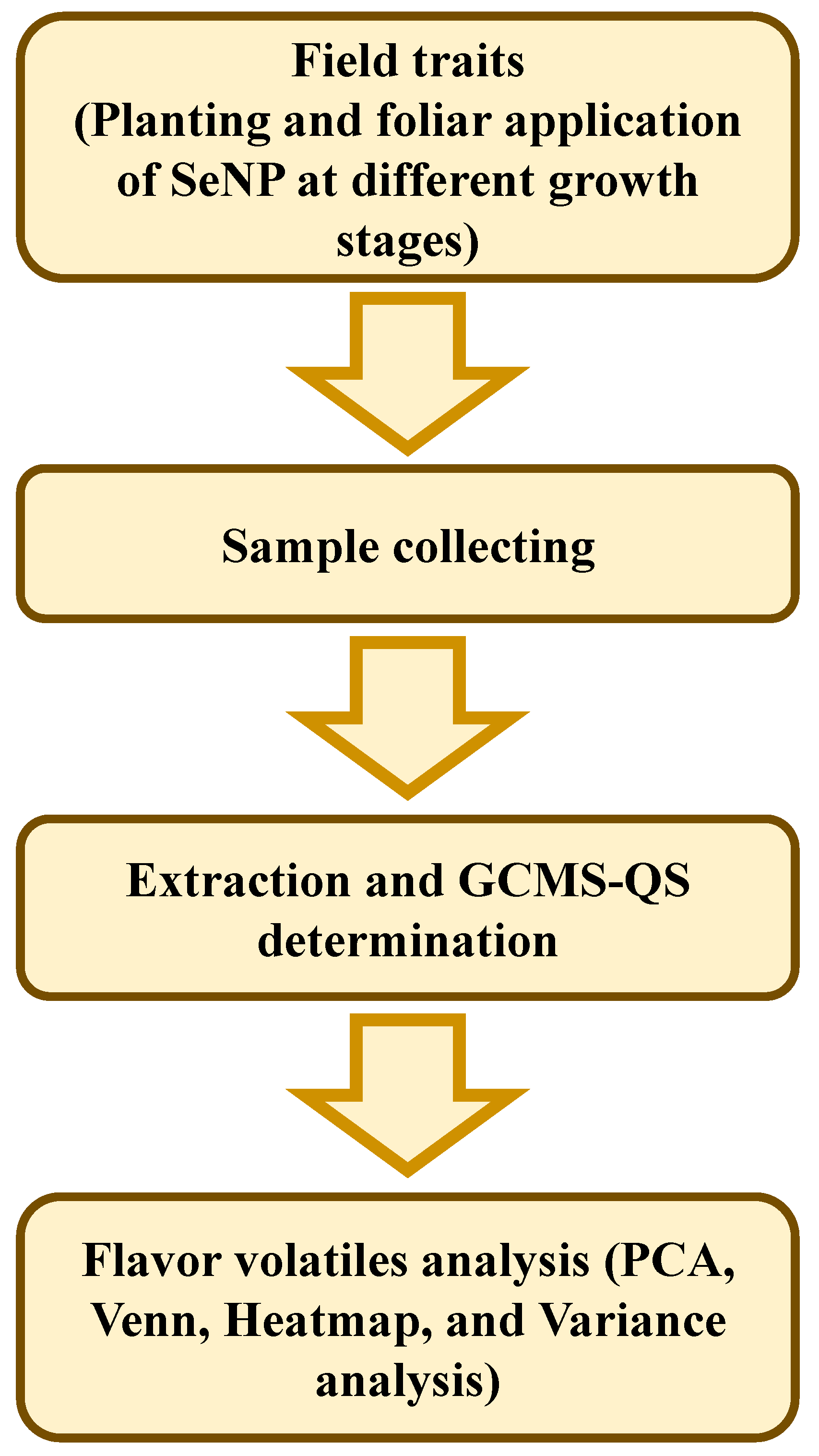
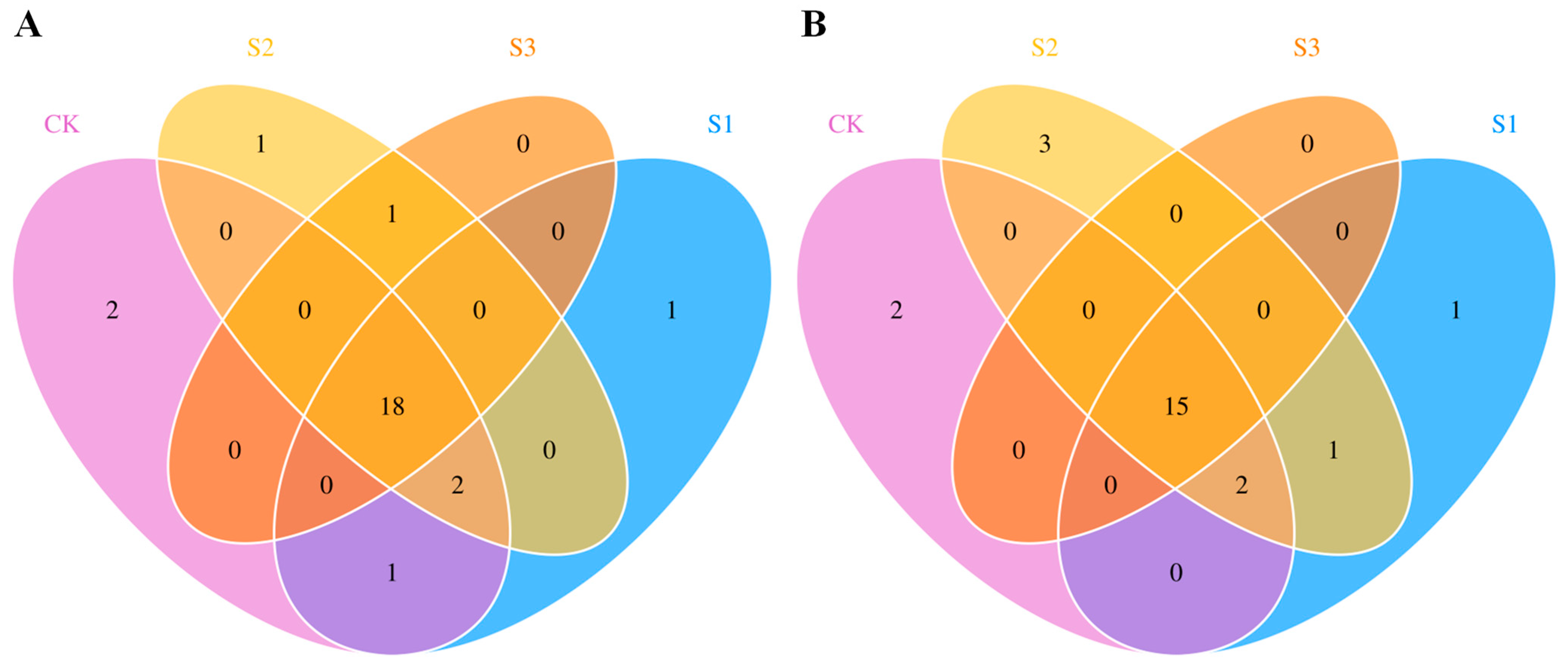
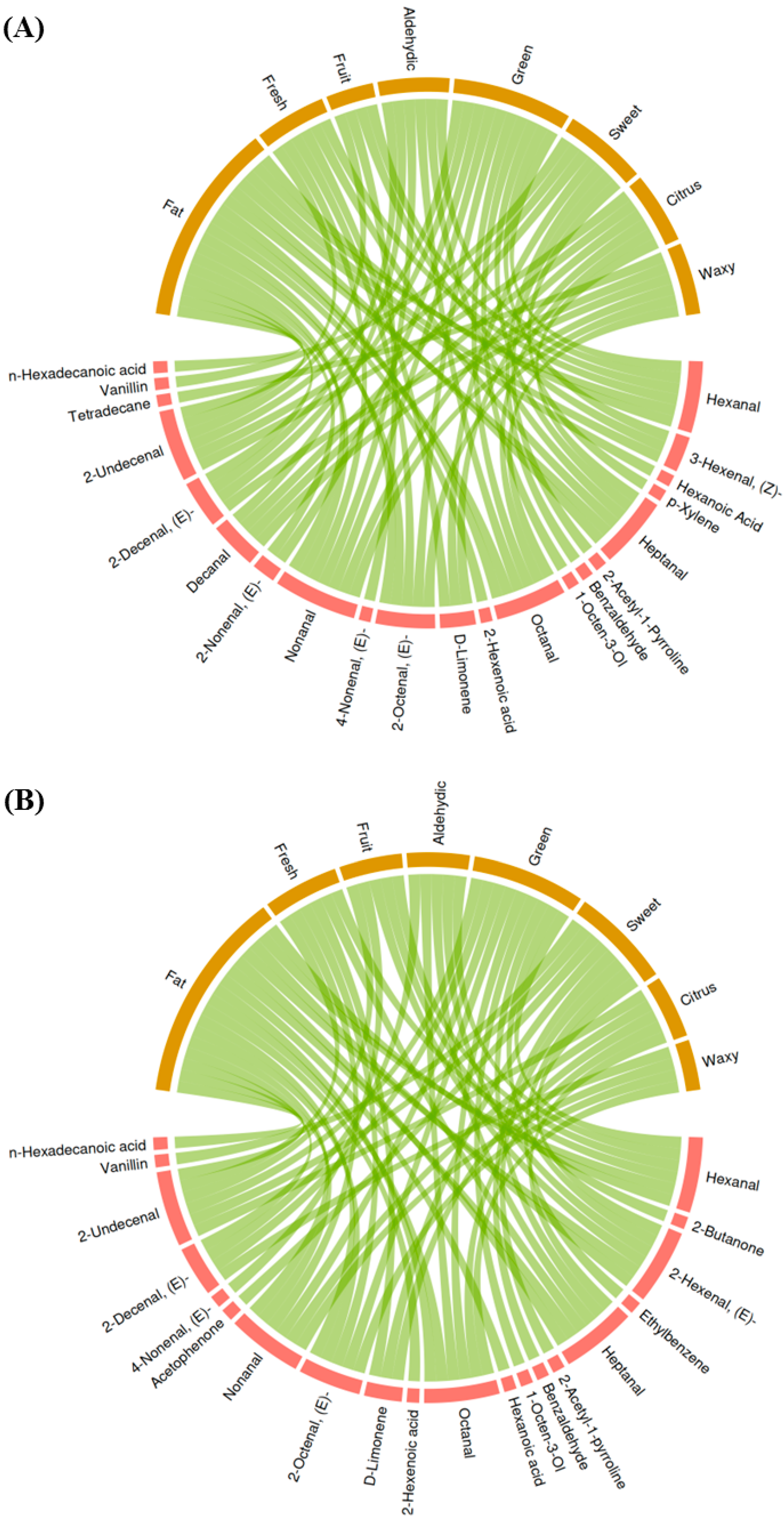
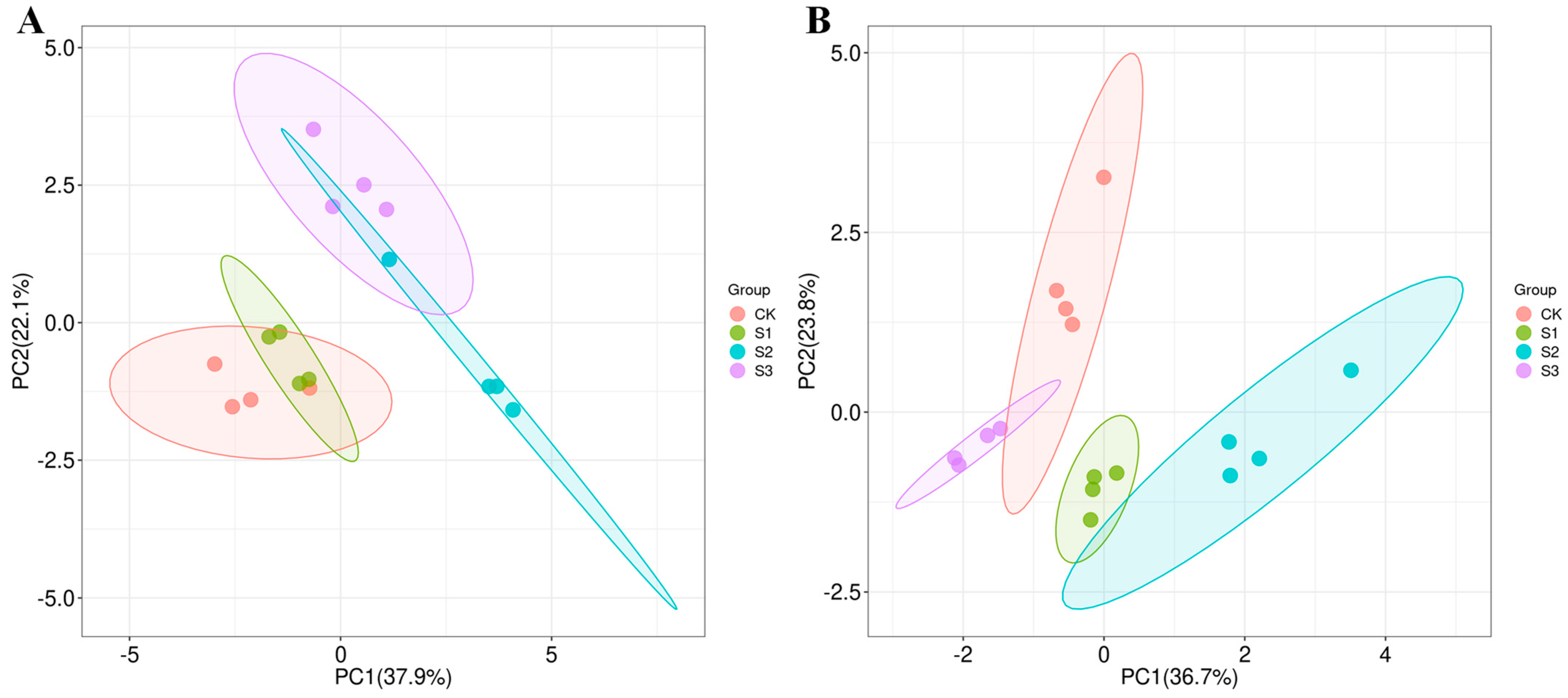
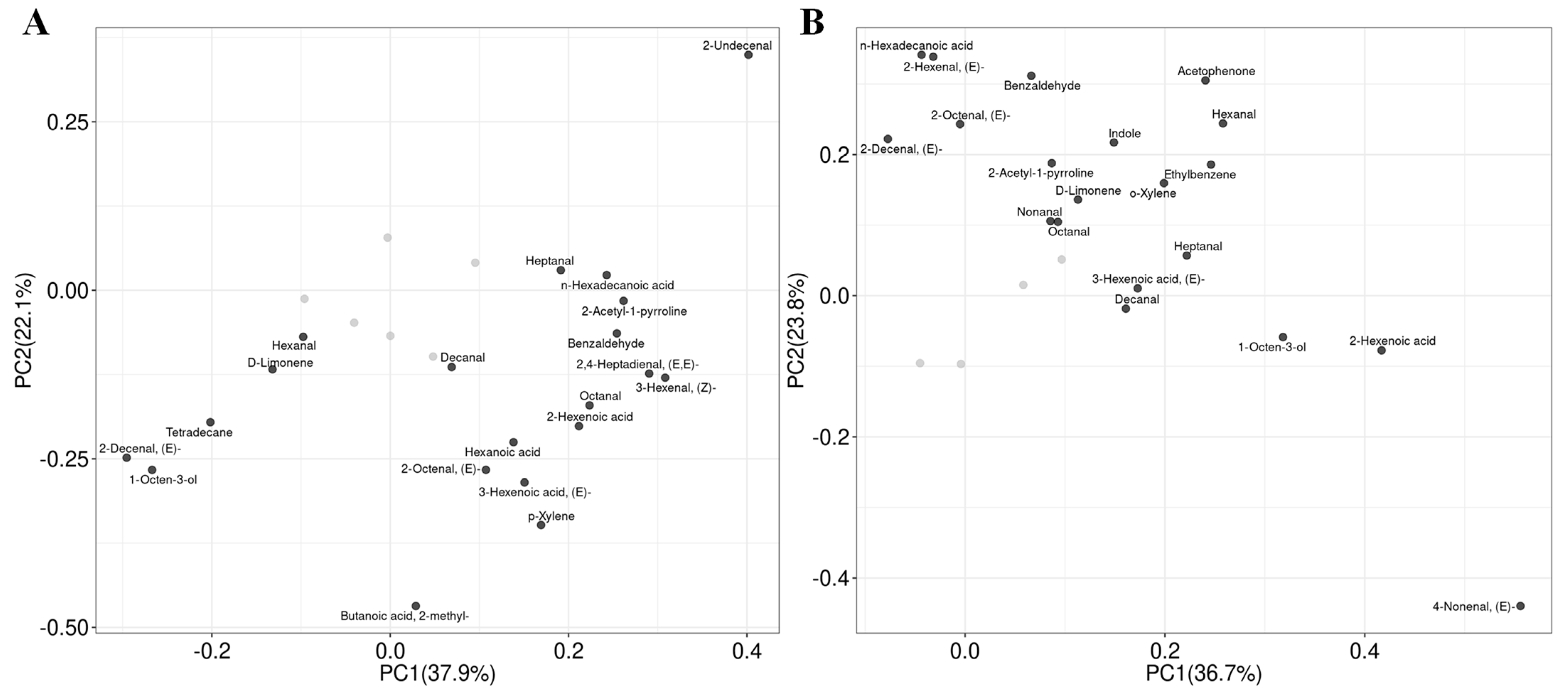
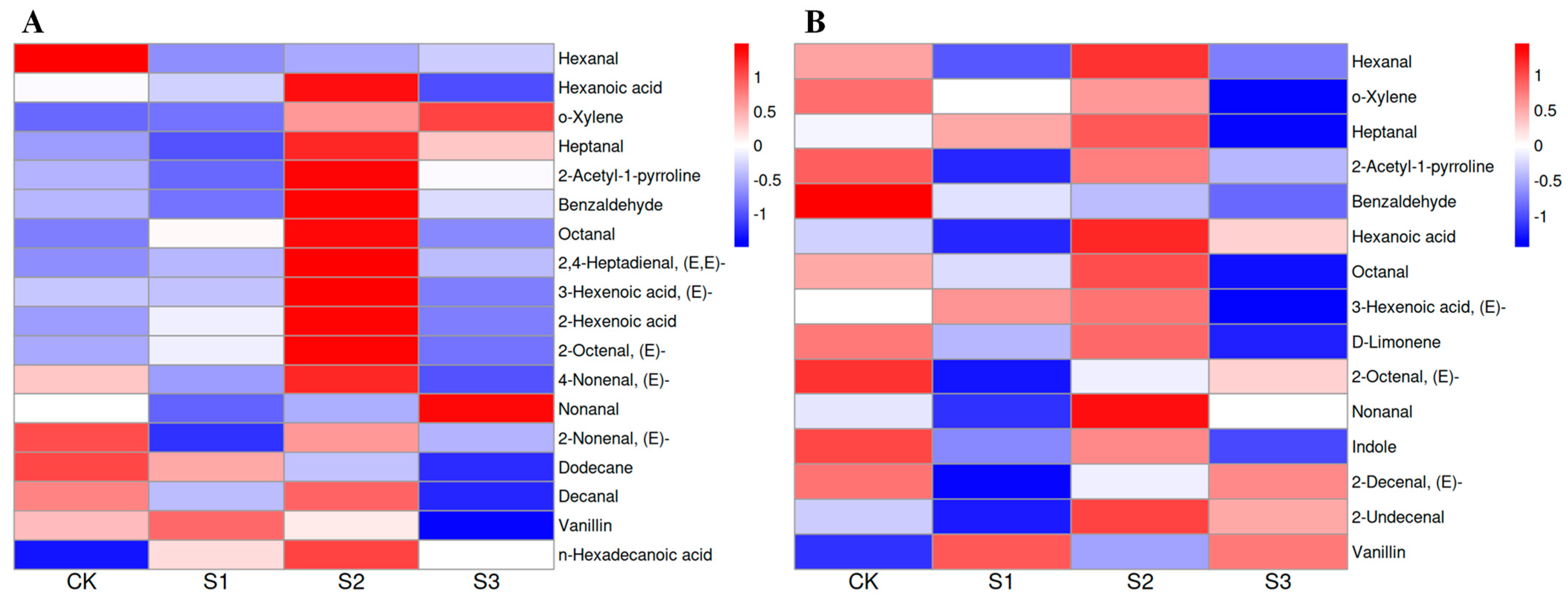
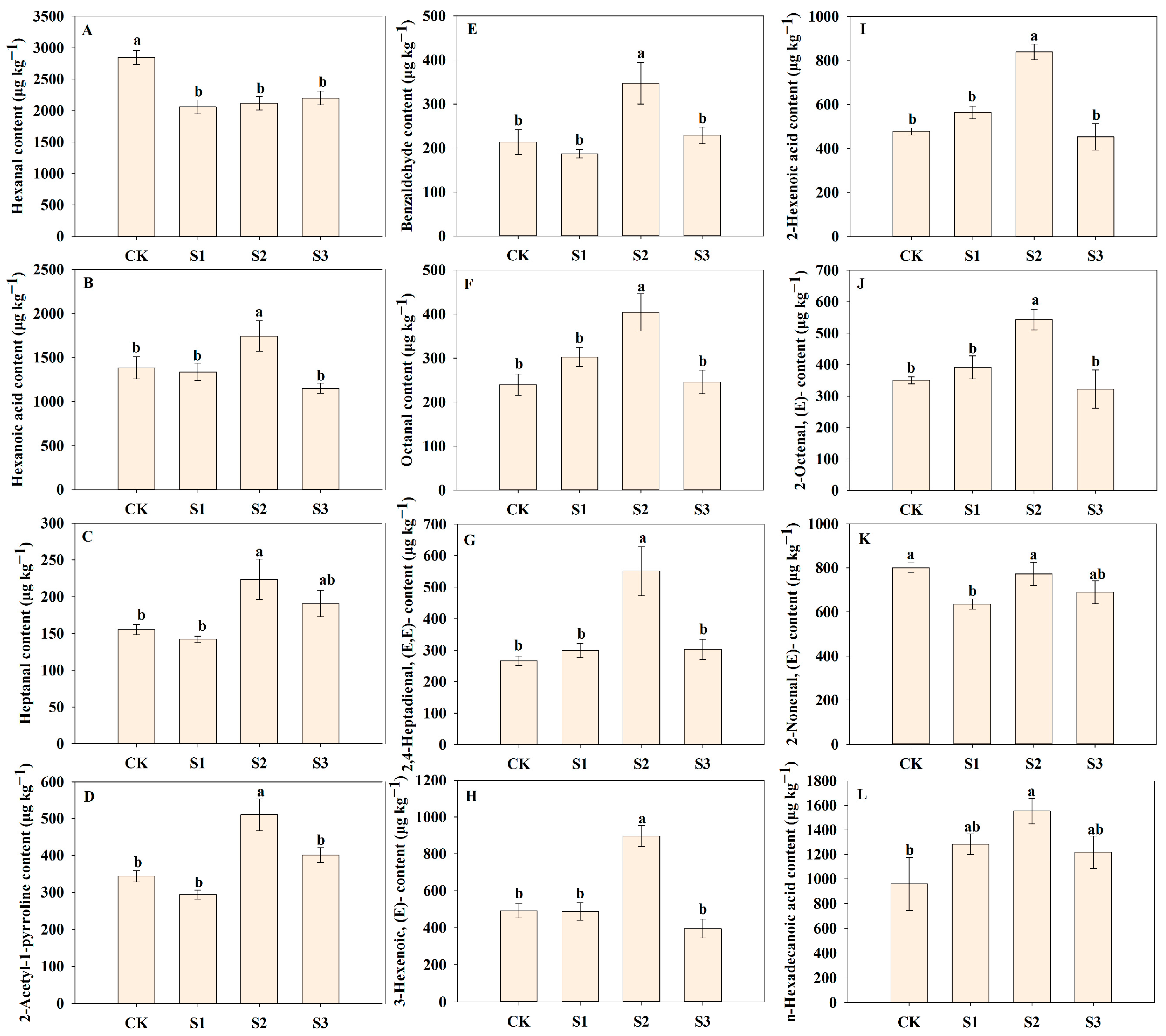
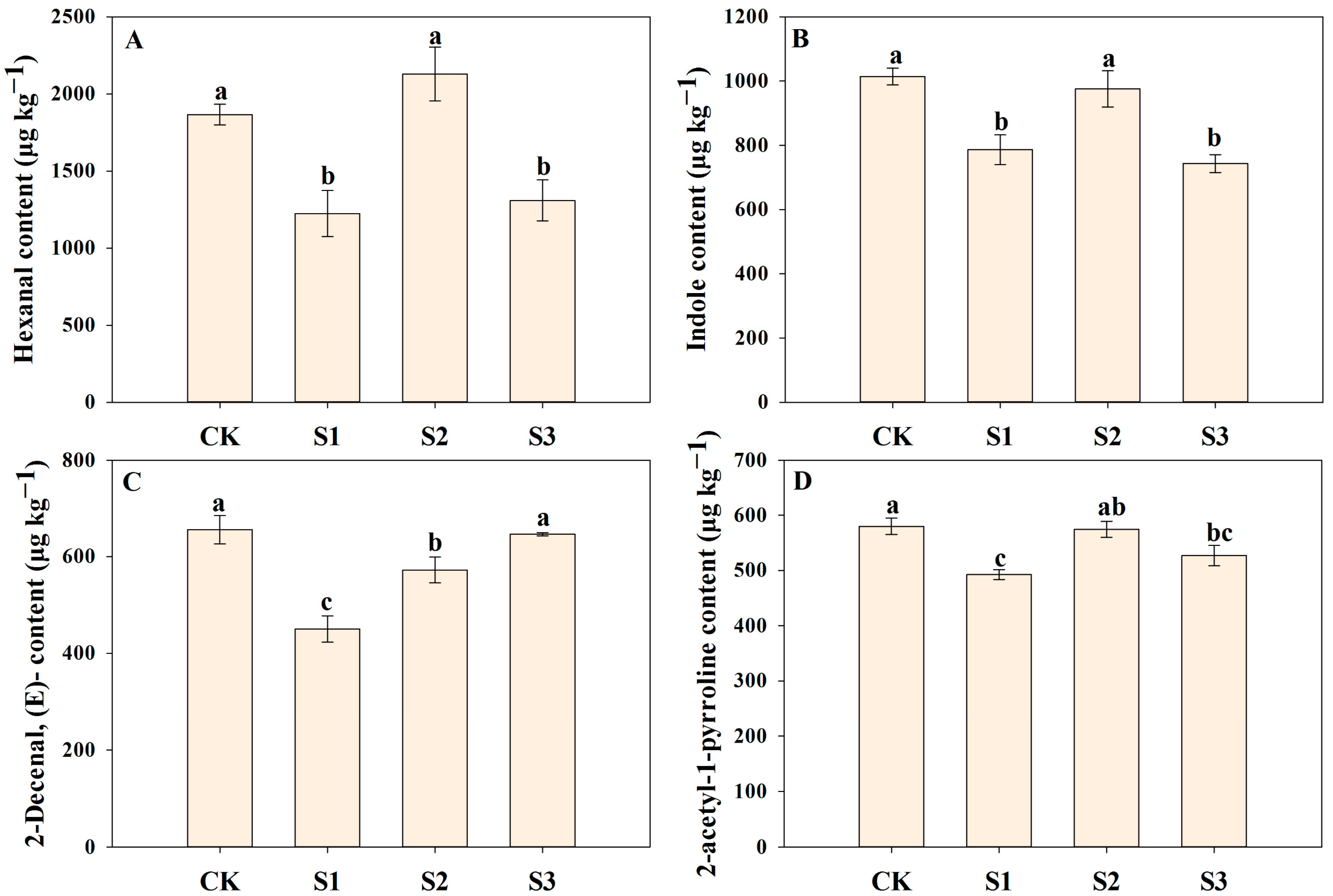
| Cropping Season | Month | Mean Temperature (°C) | Mean Maximum Temperature (°C) | Mean Minimum Temperature (°C) | Precipitation (mm) |
|---|---|---|---|---|---|
| Early season | |||||
| April | 23.63 | 28.19 | 18.76 | 77.72 | |
| May | 27.39 | 31.82 | 22.27 | 221.49 | |
| June | 29.32 | 34.46 | 25.16 | 354.33 | |
| Late season | |||||
| August | 29.82 | 34.83 | 25.02 | 237.49 | |
| September | 28.97 | 33.41 | 24.77 | 427.99 | |
| October | 25.43 | 30.14 | 20.36 | 62.99 | |
| Cropping Seasons | Common Name | PubChem ID | Flavor Profile | Molecular Formula |
|---|---|---|---|---|
| Early season | ||||
| Hexanal | 6184 | leafy, grass, sweaty, tallow, fat, fresh, fruit, aldehydic, green | C6H12O | |
| 3-Hexenal, (Z)- | 643941 | apple, fat, fruit, leaf, grassy, weedy, green | C6H10O | |
| Butanoic acid, 2-methyl- | 8314 | sour, sweat, acid, strawberry, roquefort cheese, pungent, cheese | C5H10O2 | |
| Hexanoic Acid | 8892 | fat, sour, sweat, cheese | C6H12O2 | |
| O-Xylene | 7237 | geranium | C8H10 | |
| p-Xylene | 7809 | sweet | C8H10 | |
| Heptanal | 8130 | citrus, ozone, fat, herbal, fresh, wine-lee, rancid, aldehydic, green | C7H14O | |
| 2-Acetyl-1-Pyrroline | 522834 | roast, nut, roasted, ham, sweet, nutty | C6H9NO | |
| Benzaldehyde | 240 | cherry, almond, sweet, burnt sugar, sharp, strong, bitter | C7H6O | |
| 1-Octen-3-Ol | 18827 | raw, fishy, oily, earthy, fungal, chicken, mushroom, green | C8H16O | |
| Octanal | 454 | lemon, citrus, soap, orange peel, fat, waxy, aldehydic, green | C8H16O | |
| 2,4-Heptadienal,(E,E)- | 5283321 | hazelnut, cinnamon | C7H10O | |
| 2-Hexenoic acid | 5282707 | fat, Must | C6H10O2 | |
| D-Limonene | 440917 | mint, lemon, citrus, orange, fresh, sweet | C10H16 | |
| 2-Octenal, (E)- | 5283324 | nut, fat, herbal, fresh, green, banana, waxy, leaf, cucumber | C8H14O | |
| 4-Nonenal, (E)- | 5283337 | fruit | C9H16O | |
| Nonanal | 31289 | citrus, lime, orange peel, rose, fat, green, fishy, waxy, fresh, peely, aldehydic, orris, grapefruit | C9H18O | |
| 2-Nonenal, (E)- | 5283335 | waxy, green, fat, paper, melon, cucumber | C9H16O | |
| Dodecane | 8182 | alkane | C12H26 | |
| Decanal | 8175 | citrus, soap, orange peel, tallow, waxy, floral, sweet, aldehydic | C10H20O | |
| 2-decenal,(E)- | 5283345 | orange, coriander, rose, tallow, waxy, oily, fat, earthy, floral, aldehydic, mushroom, green | C10H18O | |
| 2-Undecenal | 5283356 | citrus, soap, orange peel, fat, fresh, sweet, fruit, green | C11H20O | |
| Tetradecane | 12389 | alkane, waxy, mild | C14H30 | |
| Vanillin | 1183 | vanilla, chocolate, sweet, creamy | C8H8O3 | |
| n-Hexadecanoic acid | 985 | fat, slightly waxy | C16H32O2 | |
| Late season | ||||
| Hexanal | 6184 | leafy, grass, sweaty, tallow, fat, fresh, fruit, aldehydic, green | C6H12O | |
| 2-Butanone | 6569 | ethereal, ether, fruit, acetone, camphor | C4H8O | |
| 2-Hexenal, (E)- | 5281168 | leafy, apple, cheesy, vegetable, fat, banana, rancid, sweet, plum, fruit, aldehydic, almond, green | C6H10O | |
| Ethylbenzene | 7500 | sweet | C8H10 | |
| o-Xylene | 7237 | geranium | C8H10 | |
| Heptanal | 8130 | citrus, ozone, fat, herbal, fresh, wine-lee, rancid, aldehydic, green | C7H14O | |
| 2-Acetyl-1-pyrroline | 522834 | roast, nut, roasted, ham, sweet, nutty | C6H9NO | |
| Benzaldehyde | 240 | cherry, almond, sweet, burnt sugar, sharp, strong, bitter | C7H6O | |
| 1-Octen-3-Ol | 18827 | raw, fishy, oily, earthy, fungal, chicken, mushroom, green | C8H16O | |
| Hexanoic acid | 8892 | fat, sour, sweat, cheese | C6H12O2 | |
| Octanal | 454 | lemon, citrus, soap, orange peel, fat, waxy, fat, aldehydic, green | C8H16O | |
| 2-Hexenoic acid | 5282707 | fat, must | C6H10O2 | |
| D-Limonene | 440917 | mint, lemon, citrus, orange, fresh, sweet | C10H16 | |
| 2-Octenal, (E)- | 5283324 | nut, fat, herbal, fresh, green, banana, waxy, leaf, cucumber | C8H14O | |
| Nonanal | 31289 | citrus, lime, orange peel, rose, fat, green, fishy, waxy, fresh, peely, aldehydic, orris, grapefruit | C9H18O | |
| Acetophenone | 7410 | mimosa, hawthorn, sweet, acacia, almond, pungent, hawthorne, chemical, flower, bitter, must | C8H8O | |
| 4-Nonenal, (E)- | 5283337 | fruit | C9H16O | |
| 2-decenal,(E)- | 5283345 | orange, coriander, rose, tallow, waxy, oily, fat, earthy, floral, aldehydic, mushroom, green | C10H18O | |
| Indole | 798 | burnt, jasmine, mothball, animal, fishy, floral, moth ball, naphthelene, honey, fecal | C8H7N | |
| 2-Undecenal | 5283356 | citrus, soap, orange peel, fat, fresh, sweet, fruit, green | C11H20O | |
| Vanillin | 1183 | vanilla, chocolate, sweet, creamy | C8H8O3 | |
| n-Hexadecanoic acid | 985 | fat, slightly waxy | C16H32O2 |
Disclaimer/Publisher’s Note: The statements, opinions and data contained in all publications are solely those of the individual author(s) and contributor(s) and not of MDPI and/or the editor(s). MDPI and/or the editor(s) disclaim responsibility for any injury to people or property resulting from any ideas, methods, instructions or products referred to in the content. |
© 2025 by the authors. Licensee MDPI, Basel, Switzerland. This article is an open access article distributed under the terms and conditions of the Creative Commons Attribution (CC BY) license (https://creativecommons.org/licenses/by/4.0/).
Share and Cite
Luo, H.; Zhang, S.; Pu, X.; Xia, L.; Yi, W.; Yu, X.; Zuo, C.; Tang, X. Effects of Selenium Nanoparticle Application on Flavor Volatiles of Aromatic Rice. Foods 2025, 14, 552. https://doi.org/10.3390/foods14040552
Luo H, Zhang S, Pu X, Xia L, Yi W, Yu X, Zuo C, Tang X. Effects of Selenium Nanoparticle Application on Flavor Volatiles of Aromatic Rice. Foods. 2025; 14(4):552. https://doi.org/10.3390/foods14040552
Chicago/Turabian StyleLuo, Haowen, Simin Zhang, Xiaojuan Pu, Longfei Xia, Wentao Yi, Xianghai Yu, Changjian Zuo, and Xiangru Tang. 2025. "Effects of Selenium Nanoparticle Application on Flavor Volatiles of Aromatic Rice" Foods 14, no. 4: 552. https://doi.org/10.3390/foods14040552
APA StyleLuo, H., Zhang, S., Pu, X., Xia, L., Yi, W., Yu, X., Zuo, C., & Tang, X. (2025). Effects of Selenium Nanoparticle Application on Flavor Volatiles of Aromatic Rice. Foods, 14(4), 552. https://doi.org/10.3390/foods14040552






